I have a borderless winForm which I needed to resize, and I managed to do it this way:
protected override void WndProc(ref Message m)
{
const int wmNcHitTest = 0x84;
const int htLeft = 10;
const int htRight = 11;
const int htTop = 12;
const int htTopLeft = 13;
const int htTopRight = 14;
const int htBottom = 15;
const int htBottomLeft = 16;
const int htBottomRight = 17;
if (m.Msg == wmNcHitTest)
{
Console.Write(true + "\n");
int x = (int)(m.LParam.ToInt64() & 0xFFFF);
int y = (int)((m.LParam.ToInt64() & 0xFFFF0000) >> 16);
Point pt = PointToClient(new Point(x, y));
Size clientSize = ClientSize;
///allow resize on the lower right corner
if (pt.X >= clientSize.Width - 16 && pt.Y >= clientSize.Height - 16 && clientSize.Height >= 16)
{
m.Result = (IntPtr)(IsMirrored ? htBottomLeft : htBottomRight);
return;
}
///allow resize on the lower left corner
if (pt.X <= 16 && pt.Y >= clientSize.Height - 16 && clientSize.Height >= 16)
{
m.Result = (IntPtr)(IsMirrored ? htBottomRight : htBottomLeft);
return;
}
///allow resize on the upper right corner
if (pt.X <= 16 && pt.Y <= 16 && clientSize.Height >= 16)
{
m.Result = (IntPtr)(IsMirrored ? htTopRight : htTopLeft);
return;
}
///allow resize on the upper left corner
if (pt.X >= clientSize.Width - 16 && pt.Y <= 16 && clientSize.Height >= 16)
{
m.Result = (IntPtr)(IsMirrored ? htTopLeft : htTopRight);
return;
}
///allow resize on the top border
if (pt.Y <= 16 && clientSize.Height >= 16)
{
m.Result = (IntPtr)(htTop);
return;
}
///allow resize on the bottom border
if (pt.Y >= clientSize.Height - 16 && clientSize.Height >= 16)
{
m.Result = (IntPtr)(htBottom);
return;
}
///allow resize on the left border
if (pt.X <= 16 && clientSize.Height >= 16)
{
m.Result = (IntPtr)(htLeft);
return;
}
///allow resize on the right border
if (pt.X >= clientSize.Width - 16 && clientSize.Height >= 16)
{
m.Result = (IntPtr)(htRight);
return;
}
}
else
{
Console.Write(false + "\n");
}
base.WndProc(ref m);
}
The problem is that there are controls on the left and right borders of my form, so the resize override used on the code above doesn't work on those areas in which there are controls of any kind.
Here is an example:

On the image above you can see that the label inside the marked area is on the left border of my form and it won't let me resize it.
Is there a way to solve this issue?